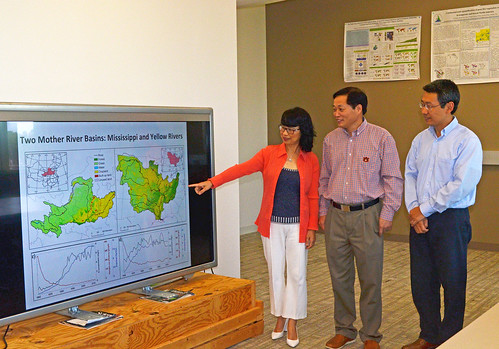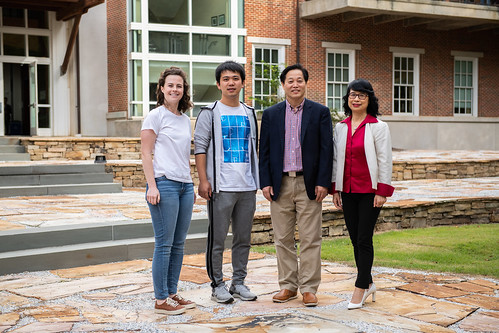Three Auburn faculty members and their international co-researchers have received a major National Science Foundation grant to lead a study on climate and global changes that will affect the sustainability of food, energy and water, or FEW, resources for the rapidly growing populations in the United States, China and beyond.
Professors Hanqin Tian and Shufen “Susan” Pan of the School of Forestry and Wildlife Sciences and Professor Ruiqing Miao of the Department of Agricultural Economics and Rural Sociology in the College of Agriculture, along with their fellow researchers in China, received a $1 million grant, jointly funded by the NSF and the National Natural Science Foundation of China, or NSFC. The group will conduct research on both the Mississippi River Basin and China’s Yellow River Basin.
The three Auburn faculty members are affiliated with Auburn University’s interdisciplinary cluster program in Climate, Human and Earth System Sciences, or CHESS, directed by Tian within the School of Forestry and Wildlife Sciences’ International Center for Climate and Global Change Research.
The U.S. and China, the two largest economies on earth, also share significant challenges in environmental sustainability, Tian said. The project, “Integrated systems modeling for sustainable FEW nexuses under multi-factor global changes: Innovative comparison between Yellow River and Mississippi River Basins,” will examine increasing challenges in both locations, including limited natural resources and multifactor global changes, now and in the coming decades.
“The co-funded research project provides an excellent opportunity for the U.S.-China team collaborating on fundamental research that addresses the nexus of food, energy and water, or FEW systems, in the two mother river basins: the Mississippi River Basin and the Yellow River Basin,” said Tian, who received a 2019 Carnegie Fellowship for separate research on Asia’s food security and global environmental sustainability.
Pan said the project will have global implications.
“We intend to develop and provide a systems solution for achieving the U.N. sustainable development goals, particularly associated with FEW sustainability and human health at both river basins, which play vital roles in global sustainability,” said Pan, who is director of Auburn’s GIS and Remote Sensing Laboratory. “The U.S.-China joint program will test different FEW connections and form a quantitative modeling tool that is applicable to other intensively managed landscapes with similar FEW conflicts across the world.”
Pan recently received two NSF grants, including another $3 million award with the Auburn team of NSF Research Traineeship, or NRT, for a project titled “NRT: Addressing resiliency to climate-related hazards and disasters through data-informed decision making.”
The U.S.-China research, together with the NRT project, will make way for further pioneering studies worldwide, Pan said.
“Both NSF projects are excellent testimonies of the interdisciplinary research that Auburn University’s CHESS cluster promotes,” Pan said. “As members of the Auburn Family, we greatly appreciate NSF’s support for both research and education at Auburn University and are very proud of the university’s effort to promote and lead such important interdisciplinary projects.”
The research team says the Mississippi River Basin, the largest river basin in North America, drains about 41 percent of the conterminous U.S. and most of the U.S. Corn Belt. The Yellow River Basin, China’s second-largest river basin and the cradle of Chinese civilization, drains 11.5 percent of the land area in China and is a key food and energy-producing region, supporting 107 million residents.
Qiang Yu, the leader of China-based team, said the joint project’s aim is to understand and quantify the complex interactions and feedback within the FEW systems, toward the regional application of the sustainable FEW nexus model.
“It is clearly important to the human well-being of both nations and beyond,” Yu said of this understanding and quantification. “The Mississippi River Basin in the U.S. and the Yellow River Basin in China are facing divergent FEW conflicts under different resource limitations and environmental stresses. “This project will evaluate and predict multi-faceted impacts of global change on FEW systems and support people and our society in developing mitigation and adaptation strategies.”
Miao said this is a first-of-its-kind undertaking, likely to make a significant scientific and human-level, impact.
“I am extremely excited about this project,” Miao said. “It is a truly interdisciplinary collaboration that synergizes the team’s expertise in ecology, economics and Big Data to tackle a problem of national and international importance.”
Pan added that outcomes from the NSF/NSFC project will shed light on optimizing resource-use efficiencies and predicting FEW sustainability under multiple-factor global changes, with consideration of the spatial diversity that exists among the environmental and socioeconomic drivers.
Other collaborative institutions participating this NSF/NSFC project include Iowa State University, Nanjing Hydraulic Research Institute, Institute of Soil and Water Conservation at the Chinese Academy of Sciences and the Northwest Agriculture and Forestry University.
(Written by Teri Greene)












